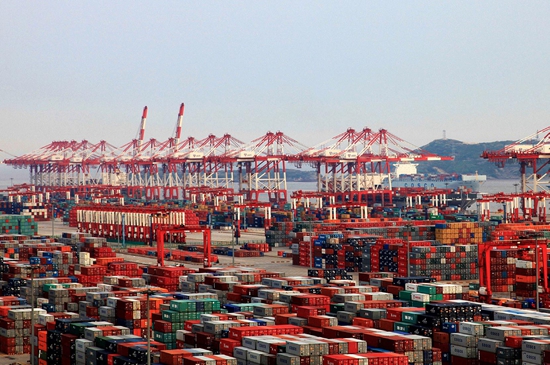
-
Vessels queue up at Shanghai Port to load and unload cargo as operations pick up
-
Port operations seen returning to normal before October, when the cargo backlog at the terminals are cleared
-
Action plan of 50 measures seeks to put the Shanghai economy back on track
Shanghai Port, the largest gateway in the world, is humming with activity again after a two-month stringent lockdown that authorities imposed on the city of 25 million to fight a wave of Covid-19 infections was lifted by the government on June 1.
Container ships queued up at the port on Tuesday, May 31, in anticipation of the lifting of the lockdown with operations expected to pick up as trucks return to load containers to clear a huge backlog at the port’s terminals.
Daily throughput stood at 120,000 TEUs as of May 31, returning to 95.3% normal, Chinese newspaper Global Times quoted port officials as saying. In contrast, container throughput was at 84% in April 2021, the report said.
Operations should return to normal before October, when stacks of unwithdrawn containers, loaded or empty, are expected to be cleared, according to shipping experts.
“This is a moment that we have been looking forward to for a long time,” the Shanghai municipal government said in a statement on social media on Wednesday. “Because of the impact of the epidemic, Shanghai, a megacity, entered an unprecedented period of silence.”
Global Times said data provider Elane Inc. shared statistics at end-April, mid-May and end-May, showing port congestion has eased, with the average waiting time for ships to anchor falling to 29 hours at end-May after rising to 71 hours in mid-May from 28 at end-April.
The newspaper said 34 vessels were waiting in mid-May compared with 30 at end-May, both up from end-April’s 23, suggesting shorter wait for ships now as port efficiency improves.
Trucks loaded with 40-foot containers were seen entering and leaving the gates of Shanghai’s Port No.1 terminal on June 1 as giant gantry cranes were busy unloading import containers and loading new ones stuffed with China’s exports that had piled up during the lockdown.
Danish shipping giant Maersk confirmed that port operations in Shanghai were returning to normal on June 1.
“All depots in Shanghai have resumed from 1st June. Shanghai warehouse operations will resume work from 1st June. Drivers need negative NAT (nucleic acid test) report within 72 hours, health code and travel code when gating in warehouses,” Maersk latest advisory said.
The city government said the port never stopped operating but activity was limited to half even as it put 20,000 workers in a closed-loop system where they lived and worked onsite.
Carmakers like Tesla and Volkwagen are also operating in a closed-loop system as they ramp up production to clear order backlogs when they halted operations in April. They resumed manufacturing partially in early May in a closed-loop system where workers live in their work premises. Tesla said it will maintain that system until June 10.
Two days before lifting the lockdown, the city government announced 50 measures in an “action plan” to help Shanghai resume normal economic activity. These include ensuring the smooth flow of domestic and international logistics channels.
“The Action Plan promised Shanghai will move faster to promote the unified and mutually recognized passes across the country, improve the efficiency of trans-provincial transport transit stations, promote contactless logistics, and improve the efficiency of freight transport,” investment consultants Dezan Shira & Associates, said in its “China Review”.
The measures also include accelerating the implementation of state support policies for logistics companies. These include VAT exemption for eligible express delivery services and use “reloans” as support financing for the transport, logistics and storage industries.
The action plan set out the priority for resumption of work at different industries:
- Car, integrated circuit, bio-pharmaceutical and other manufacturing enterprises shall be prioritized to ensure coordinated resumption of production in the whole supply chain.
- Resumption of work in wholesale and retail, finance, transportation and logistics, real estate, construction and other industries shall be promoted gradually.
- Work resumption in agricultural production units shall be promoted as soon as possible.
- The resumption of work in catering, residential services, cultural tourism, exhibition, and other industries where people gather shall be promoted when conditions permit.




